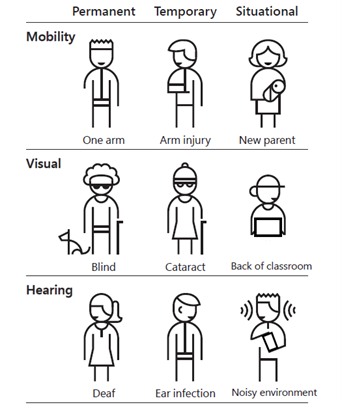A diverse and inclusive learning community strengthens our entire university.
There are approximately 34,000 students, 5,000 faculty, and 7,000 staff at the University of Pittsburgh. Our mission is to create a digital environment that they can all freely, independently, and easily access.
Making our material digitally accessible benefits everyone.  Though it is primarily aimed at those with disabilities, anyone can benefit from inclusive design:
Though it is primarily aimed at those with disabilities, anyone can benefit from inclusive design:
- Captions on videos benefit those who are in noisy environments as well as those who are deaf
- Good color contrast helps those who have color blindness but also those who may be far away from the content
- Incorporating accessible design features as a regular step in your content making process makes accessible content easy and effective from the start.
Accessible content is also governed by specific laws such as the Americans with Disabilities Act, and Section 504 and 508 of the Rehabilitation Act of 1973 that require all of our digital content to be accessible to those with disabilities. Pitt has its own governing policy as well: the Electronic Information and Technology Accessibility Policy and Procedure, which was established in 2020.
Learn more about how to integrate accessibility into your content by checking out our Accessible Content Design Hub. Here you’ll find resources on making all kinds of content accessible, including presentations, documents, and more.
If you have a backlog of content that was not originally designed with accessibility in mind, it is likely that much of it fails to meet the requirements laid out in these governing policies. We recommend following the content auditing steps laid out in our Content Auditing page to streamline the process of bringing old content into compliance.
- Digital Accessibility Tools
The University provides a number of technical resources and services to support our accessibility efforts. Learn more about what's available to help you achieve your accessibility goals.
- Report a Barrier
The University is committed to providing an environment free from barriers. Use the Report a Barrier form to notify the University of any accessibility barriers you encounter so we can assess the issue and promptly respond to the problem.
Policy and Procedure
The University of Pittsburgh is committed to ensuring equal access by making its websites and all other electronic and information technology accessible to all users.
The digital accessibility coordinator, along with a team of professionals from across the University, is responsible for coordinating and reviewing the compliance program related to the EIT Accessibility Policy as well as providing training and support to meet the goals of that policy.
Acknowledgement
Illustration this page, courtesy Microsoft Corp. Licensed under Creative Commons.
